The Red-Headed League: Unfolding the Detective Genre
VerifiedAdded on 2023/06/07
|5
|1105
|176
AI Summary
This literary analysis explores the detective genre in "The Red-Headed League" by Arthur Conan Doyle, highlighting the conventions, significance, and manifestation of the genre in the narrative. The author uses themes of bizarre, power of reason, and appearance versus reality with the motif of portraying the genre of a detective who is critical while making decisions. The role of narration and structure is also imperative in manifesting the detective genre of the narrative.
Contribute Materials
Your contribution can guide someone’s learning journey. Share your
documents today.
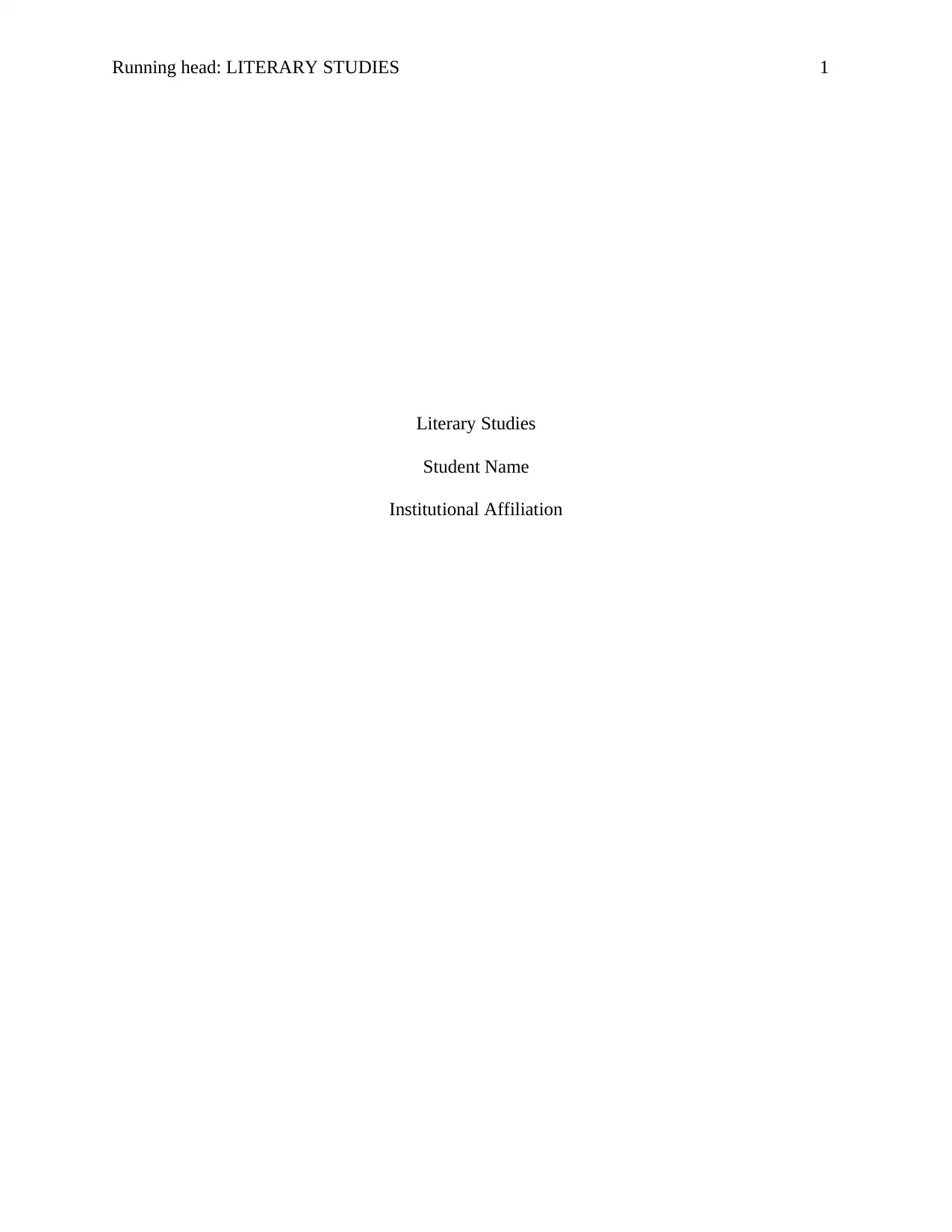
Running head: LITERARY STUDIES 1
Literary Studies
Student Name
Institutional Affiliation
Literary Studies
Student Name
Institutional Affiliation
Secure Best Marks with AI Grader
Need help grading? Try our AI Grader for instant feedback on your assignments.
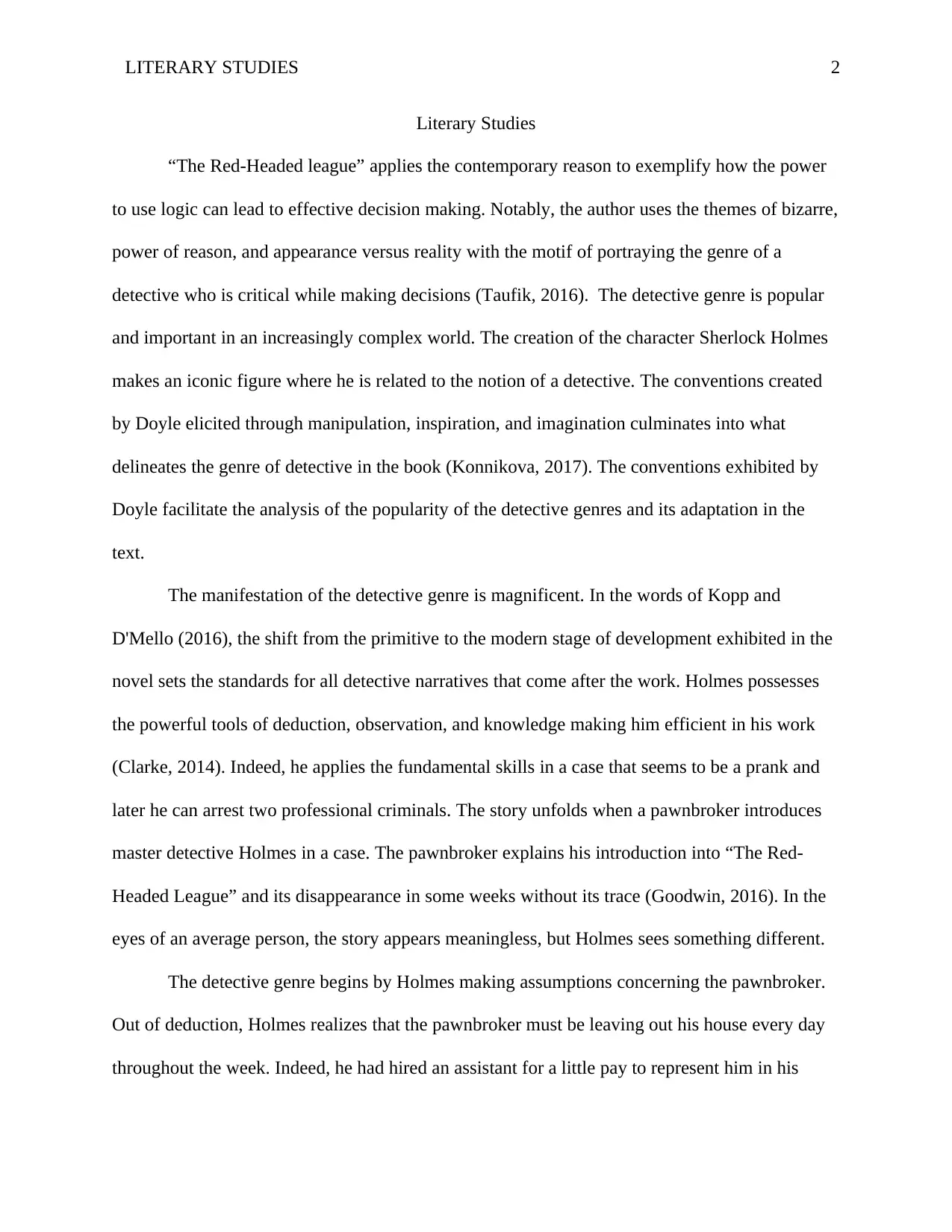
LITERARY STUDIES 2
Literary Studies
“The Red-Headed league” applies the contemporary reason to exemplify how the power
to use logic can lead to effective decision making. Notably, the author uses the themes of bizarre,
power of reason, and appearance versus reality with the motif of portraying the genre of a
detective who is critical while making decisions (Taufik, 2016). The detective genre is popular
and important in an increasingly complex world. The creation of the character Sherlock Holmes
makes an iconic figure where he is related to the notion of a detective. The conventions created
by Doyle elicited through manipulation, inspiration, and imagination culminates into what
delineates the genre of detective in the book (Konnikova, 2017). The conventions exhibited by
Doyle facilitate the analysis of the popularity of the detective genres and its adaptation in the
text.
The manifestation of the detective genre is magnificent. In the words of Kopp and
D'Mello (2016), the shift from the primitive to the modern stage of development exhibited in the
novel sets the standards for all detective narratives that come after the work. Holmes possesses
the powerful tools of deduction, observation, and knowledge making him efficient in his work
(Clarke, 2014). Indeed, he applies the fundamental skills in a case that seems to be a prank and
later he can arrest two professional criminals. The story unfolds when a pawnbroker introduces
master detective Holmes in a case. The pawnbroker explains his introduction into “The Red-
Headed League” and its disappearance in some weeks without its trace (Goodwin, 2016). In the
eyes of an average person, the story appears meaningless, but Holmes sees something different.
The detective genre begins by Holmes making assumptions concerning the pawnbroker.
Out of deduction, Holmes realizes that the pawnbroker must be leaving out his house every day
throughout the week. Indeed, he had hired an assistant for a little pay to represent him in his
Literary Studies
“The Red-Headed league” applies the contemporary reason to exemplify how the power
to use logic can lead to effective decision making. Notably, the author uses the themes of bizarre,
power of reason, and appearance versus reality with the motif of portraying the genre of a
detective who is critical while making decisions (Taufik, 2016). The detective genre is popular
and important in an increasingly complex world. The creation of the character Sherlock Holmes
makes an iconic figure where he is related to the notion of a detective. The conventions created
by Doyle elicited through manipulation, inspiration, and imagination culminates into what
delineates the genre of detective in the book (Konnikova, 2017). The conventions exhibited by
Doyle facilitate the analysis of the popularity of the detective genres and its adaptation in the
text.
The manifestation of the detective genre is magnificent. In the words of Kopp and
D'Mello (2016), the shift from the primitive to the modern stage of development exhibited in the
novel sets the standards for all detective narratives that come after the work. Holmes possesses
the powerful tools of deduction, observation, and knowledge making him efficient in his work
(Clarke, 2014). Indeed, he applies the fundamental skills in a case that seems to be a prank and
later he can arrest two professional criminals. The story unfolds when a pawnbroker introduces
master detective Holmes in a case. The pawnbroker explains his introduction into “The Red-
Headed League” and its disappearance in some weeks without its trace (Goodwin, 2016). In the
eyes of an average person, the story appears meaningless, but Holmes sees something different.
The detective genre begins by Holmes making assumptions concerning the pawnbroker.
Out of deduction, Holmes realizes that the pawnbroker must be leaving out his house every day
throughout the week. Indeed, he had hired an assistant for a little pay to represent him in his
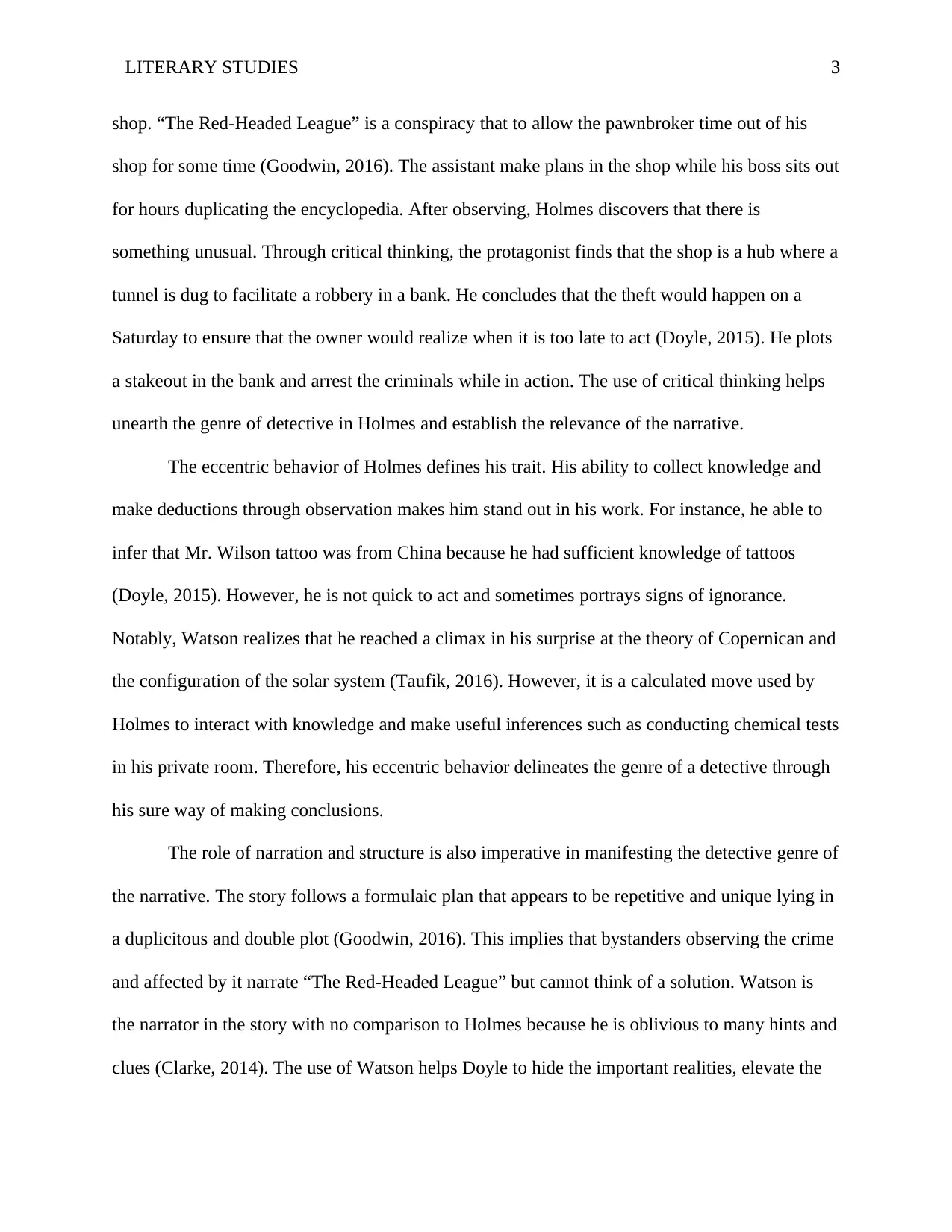
LITERARY STUDIES 3
shop. “The Red-Headed League” is a conspiracy that to allow the pawnbroker time out of his
shop for some time (Goodwin, 2016). The assistant make plans in the shop while his boss sits out
for hours duplicating the encyclopedia. After observing, Holmes discovers that there is
something unusual. Through critical thinking, the protagonist finds that the shop is a hub where a
tunnel is dug to facilitate a robbery in a bank. He concludes that the theft would happen on a
Saturday to ensure that the owner would realize when it is too late to act (Doyle, 2015). He plots
a stakeout in the bank and arrest the criminals while in action. The use of critical thinking helps
unearth the genre of detective in Holmes and establish the relevance of the narrative.
The eccentric behavior of Holmes defines his trait. His ability to collect knowledge and
make deductions through observation makes him stand out in his work. For instance, he able to
infer that Mr. Wilson tattoo was from China because he had sufficient knowledge of tattoos
(Doyle, 2015). However, he is not quick to act and sometimes portrays signs of ignorance.
Notably, Watson realizes that he reached a climax in his surprise at the theory of Copernican and
the configuration of the solar system (Taufik, 2016). However, it is a calculated move used by
Holmes to interact with knowledge and make useful inferences such as conducting chemical tests
in his private room. Therefore, his eccentric behavior delineates the genre of a detective through
his sure way of making conclusions.
The role of narration and structure is also imperative in manifesting the detective genre of
the narrative. The story follows a formulaic plan that appears to be repetitive and unique lying in
a duplicitous and double plot (Goodwin, 2016). This implies that bystanders observing the crime
and affected by it narrate “The Red-Headed League” but cannot think of a solution. Watson is
the narrator in the story with no comparison to Holmes because he is oblivious to many hints and
clues (Clarke, 2014). The use of Watson helps Doyle to hide the important realities, elevate the
shop. “The Red-Headed League” is a conspiracy that to allow the pawnbroker time out of his
shop for some time (Goodwin, 2016). The assistant make plans in the shop while his boss sits out
for hours duplicating the encyclopedia. After observing, Holmes discovers that there is
something unusual. Through critical thinking, the protagonist finds that the shop is a hub where a
tunnel is dug to facilitate a robbery in a bank. He concludes that the theft would happen on a
Saturday to ensure that the owner would realize when it is too late to act (Doyle, 2015). He plots
a stakeout in the bank and arrest the criminals while in action. The use of critical thinking helps
unearth the genre of detective in Holmes and establish the relevance of the narrative.
The eccentric behavior of Holmes defines his trait. His ability to collect knowledge and
make deductions through observation makes him stand out in his work. For instance, he able to
infer that Mr. Wilson tattoo was from China because he had sufficient knowledge of tattoos
(Doyle, 2015). However, he is not quick to act and sometimes portrays signs of ignorance.
Notably, Watson realizes that he reached a climax in his surprise at the theory of Copernican and
the configuration of the solar system (Taufik, 2016). However, it is a calculated move used by
Holmes to interact with knowledge and make useful inferences such as conducting chemical tests
in his private room. Therefore, his eccentric behavior delineates the genre of a detective through
his sure way of making conclusions.
The role of narration and structure is also imperative in manifesting the detective genre of
the narrative. The story follows a formulaic plan that appears to be repetitive and unique lying in
a duplicitous and double plot (Goodwin, 2016). This implies that bystanders observing the crime
and affected by it narrate “The Red-Headed League” but cannot think of a solution. Watson is
the narrator in the story with no comparison to Holmes because he is oblivious to many hints and
clues (Clarke, 2014). The use of Watson helps Doyle to hide the important realities, elevate the
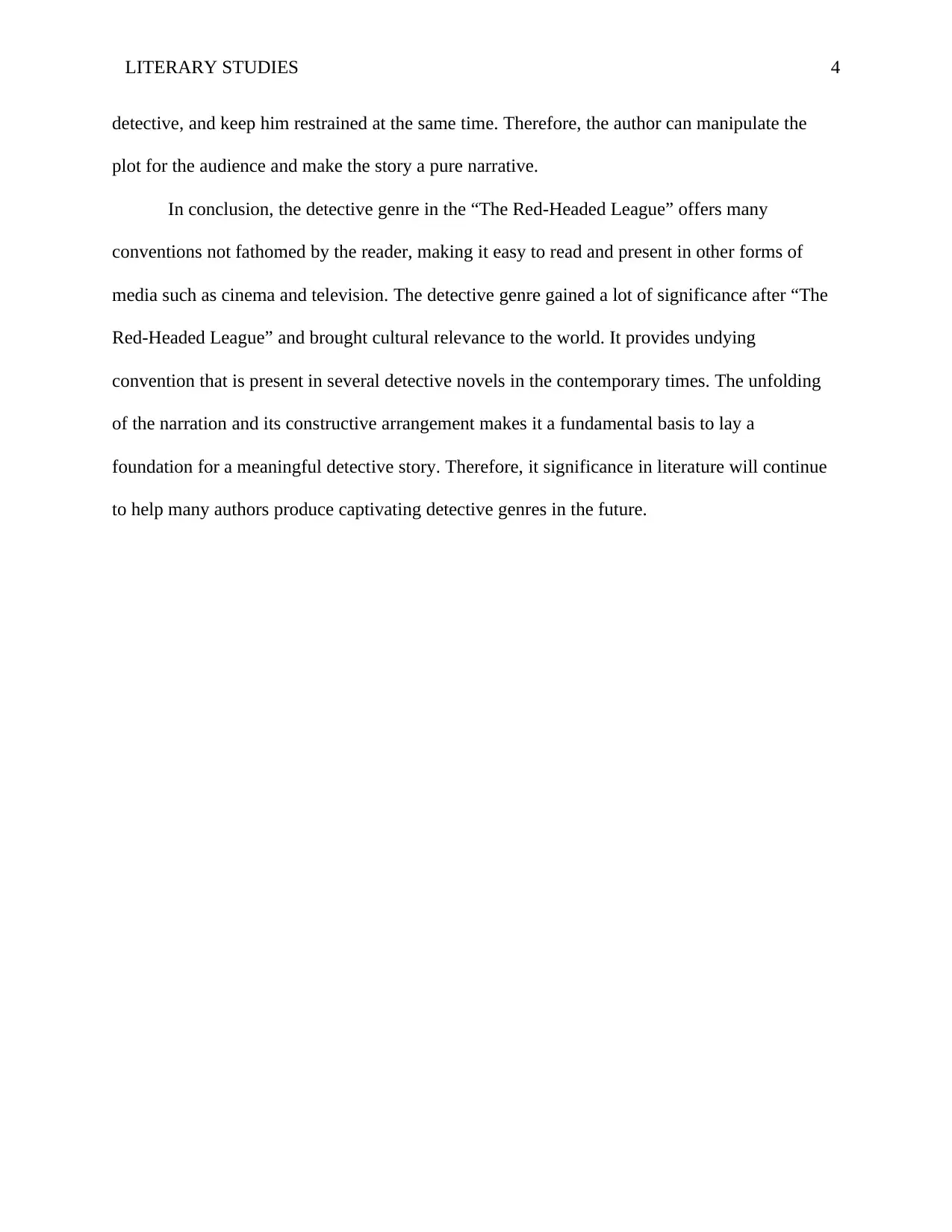
LITERARY STUDIES 4
detective, and keep him restrained at the same time. Therefore, the author can manipulate the
plot for the audience and make the story a pure narrative.
In conclusion, the detective genre in the “The Red-Headed League” offers many
conventions not fathomed by the reader, making it easy to read and present in other forms of
media such as cinema and television. The detective genre gained a lot of significance after “The
Red-Headed League” and brought cultural relevance to the world. It provides undying
convention that is present in several detective novels in the contemporary times. The unfolding
of the narration and its constructive arrangement makes it a fundamental basis to lay a
foundation for a meaningful detective story. Therefore, it significance in literature will continue
to help many authors produce captivating detective genres in the future.
detective, and keep him restrained at the same time. Therefore, the author can manipulate the
plot for the audience and make the story a pure narrative.
In conclusion, the detective genre in the “The Red-Headed League” offers many
conventions not fathomed by the reader, making it easy to read and present in other forms of
media such as cinema and television. The detective genre gained a lot of significance after “The
Red-Headed League” and brought cultural relevance to the world. It provides undying
convention that is present in several detective novels in the contemporary times. The unfolding
of the narration and its constructive arrangement makes it a fundamental basis to lay a
foundation for a meaningful detective story. Therefore, it significance in literature will continue
to help many authors produce captivating detective genres in the future.
Secure Best Marks with AI Grader
Need help grading? Try our AI Grader for instant feedback on your assignments.
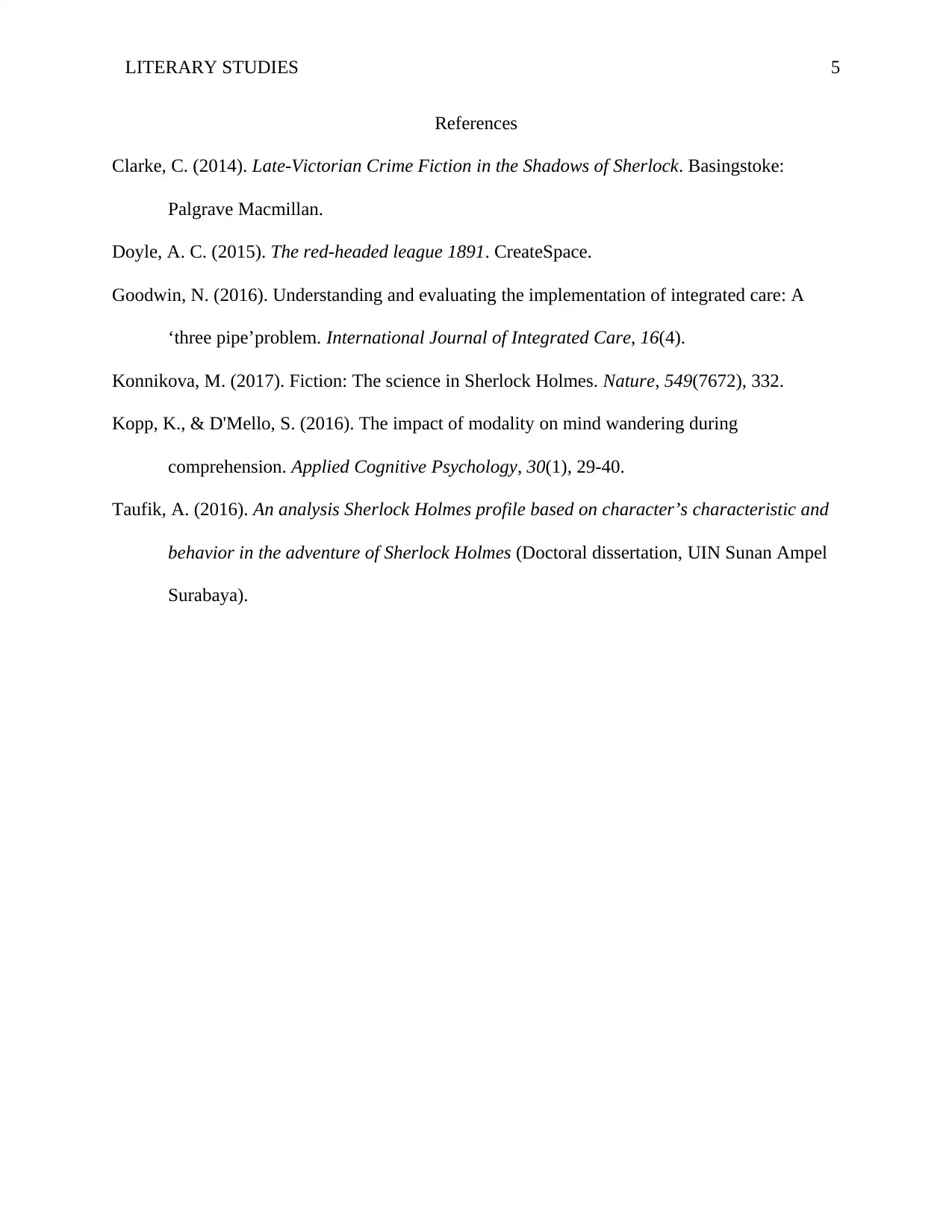
LITERARY STUDIES 5
References
Clarke, C. (2014). Late-Victorian Crime Fiction in the Shadows of Sherlock. Basingstoke:
Palgrave Macmillan.
Doyle, A. C. (2015). The red-headed league 1891. CreateSpace.
Goodwin, N. (2016). Understanding and evaluating the implementation of integrated care: A
‘three pipe’problem. International Journal of Integrated Care, 16(4).
Konnikova, M. (2017). Fiction: The science in Sherlock Holmes. Nature, 549(7672), 332.
Kopp, K., & D'Mello, S. (2016). The impact of modality on mind wandering during
comprehension. Applied Cognitive Psychology, 30(1), 29-40.
Taufik, A. (2016). An analysis Sherlock Holmes profile based on character’s characteristic and
behavior in the adventure of Sherlock Holmes (Doctoral dissertation, UIN Sunan Ampel
Surabaya).
References
Clarke, C. (2014). Late-Victorian Crime Fiction in the Shadows of Sherlock. Basingstoke:
Palgrave Macmillan.
Doyle, A. C. (2015). The red-headed league 1891. CreateSpace.
Goodwin, N. (2016). Understanding and evaluating the implementation of integrated care: A
‘three pipe’problem. International Journal of Integrated Care, 16(4).
Konnikova, M. (2017). Fiction: The science in Sherlock Holmes. Nature, 549(7672), 332.
Kopp, K., & D'Mello, S. (2016). The impact of modality on mind wandering during
comprehension. Applied Cognitive Psychology, 30(1), 29-40.
Taufik, A. (2016). An analysis Sherlock Holmes profile based on character’s characteristic and
behavior in the adventure of Sherlock Holmes (Doctoral dissertation, UIN Sunan Ampel
Surabaya).
1 out of 5
Your All-in-One AI-Powered Toolkit for Academic Success.
+13062052269
info@desklib.com
Available 24*7 on WhatsApp / Email
![[object Object]](/_next/static/media/star-bottom.7253800d.svg)
Unlock your academic potential
© 2024 | Zucol Services PVT LTD | All rights reserved.